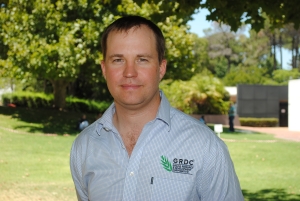Consider micronutrients when tissue testing
Consider micronutrients when tissue testing
Author: media@grdc.com.au | Date: 31 Jul 2020

Western Australian grain growers are encouraged to consider broadening crop plant tissue testing to include micronutrients as well as macronutrients such as nitrogen – in order to optimise their profitability.
Rowan Maddern, Grains Research and Development Corporation (GRDC) manager agronomy, soils and farming systems – west, said most growers did not request tissue testing for micronutrients which could limit crop production if not present in sufficient quantities.
“While soil tests work best for macronutrients, tissue tests are the most robust method of identifying a micronutrient deficiency,” Dr Maddern said.
“The micronutrient copper can be applied relatively late in the season so any deficiency can still be corrected with foliar applications. Manganese can also be applied relatively late on lupins and cereals, depending on the crop growth stage.
“Tissue testing results can also be used to help growers plan requirements for applications of granular micronutrient fertilisers in the following season and maximise their return on investment into fertilisers.”
Dr Maddern said organising a ‘complete analysis’ for tissue testing, including micronutrients, paid off even if results showed crops did in fact have adequate supplies of micronutrients, as growers would know they did not need to make unnecessary applications.
He said a GRDC-invested study led by the Liebe Group in recent years found while 44 per cent of growers surveyed (in medium-to-low rainfall areas of WA’s Northern Agricultural Region) thought their crops had micronutrient deficiencies, only a small proportion of crop plant samples were actually deficient.
Plant sampling, conducted at the mid tillering stage in 2018, showed 17 per cent of plant samples had zinc levels considered to be marginal, with only 5 per cent considered deficient, and 6.75 per cent of samples had marginal manganese levels, with 2.25 per cent considered deficient.
No copper deficiencies were identified in the plant sample survey.
“The project highlighted that micronutrients are often applied prophylactically to the crop in standard cropping systems – a cost that may be unnecessary if tissue testing confirms adequate micronutrient levels are present,” Dr Maddern said.
A literature review conducted as part of the Liebe Group project, with support from fertiliser manufacturer and supplier CSBP and Murdoch University, highlighted too much micronutrient supply created a toxicity and too little caused deficiency – with both having a negative impact on crop yield and quality.
“Deficiencies may be inaccurately diagnosed or mistaken for other environmental stresses unless a plant sample is analysed to confirm the deficient nutrient. Not all deficient plants will display symptoms,” the review stated.
The review also found plant sampling was a tool not as widely adopted by growers as on-farm soil sampling, and understanding was lacking regarding its usefulness as a decision-making tool.
“Plant testing allows growers to make informed and timely fertiliser decisions that may improve crops yield potential if managed with the correct product, at the correct rate and at the correct crop growth stage,” it stated.
A GRDC YouTube video ‘Managing micronutrient deficiencies’, includes information about the GRDC-invested project led by the Liebe Group.
More information about diagnosing and treating micronutrient deficiencies is available in the GRDC Micronutrient Fact Sheet.
Information about monitoring plant nutrition levels, including micronutrients, is also available on the Department of Primary Industries and Regional Development website.
Contact details
Contract
media@grdc.com.au – West
0427 189 827
media@grdc.com.au
GRDC Project Code: LIE1802-001SAX,
